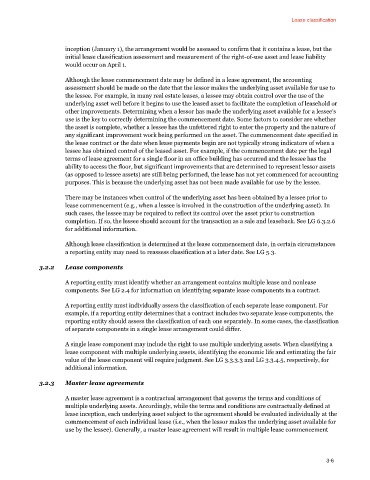Page 72 - pwc-lease-accounting-guide_Neat
P. 72
Lease classification
inception (January 1), the arrangement would be assessed to confirm that it contains a lease, but the
initial lease classification assessment and measurement of the right-of-use asset and lease liability
would occur on April 1.
Although the lease commencement date may be defined in a lease agreement, the accounting
assessment should be made on the date that the lessor makes the underlying asset available for use to
the lessee. For example, in many real estate leases, a lessee may obtain control over the use of the
underlying asset well before it begins to use the leased asset to facilitate the completion of leasehold or
other improvements. Determining when a lessor has made the underlying asset available for a lessee’s
use is the key to correctly determining the commencement date. Some factors to consider are whether
the asset is complete, whether a lessee has the unfettered right to enter the property and the nature of
any significant improvement work being performed on the asset. The commencement date specified in
the lease contract or the date when lease payments begin are not typically strong indicators of when a
lessee has obtained control of the leased asset. For example, if the commencement date per the legal
terms of lease agreement for a single floor in an office building has occurred and the lessee has the
ability to access the floor, but significant improvements that are determined to represent lessor assets
(as opposed to lessee assets) are still being performed, the lease has not yet commenced for accounting
purposes. This is because the underlying asset has not been made available for use by the lessee.
There may be instances when control of the underlying asset has been obtained by a lessee prior to
lease commencement (e.g., when a lessee is involved in the construction of the underlying asset). In
such cases, the lessee may be required to reflect its control over the asset prior to construction
completion. If so, the lessee should account for the transaction as a sale and leaseback. See LG 6.3.2.6
for additional information.
Although lease classification is determined at the lease commencement date, in certain circumstances
a reporting entity may need to reassess classification at a later date. See LG 5.3.
3.2.2 Lease components
A reporting entity must identify whether an arrangement contains multiple lease and nonlease
components. See LG 2.4 for information on identifying separate lease components in a contract.
A reporting entity must individually assess the classification of each separate lease component. For
example, if a reporting entity determines that a contract includes two separate lease components, the
reporting entity should assess the classification of each one separately. In some cases, the classification
of separate components in a single lease arrangement could differ.
A single lease component may include the right to use multiple underlying assets. When classifying a
lease component with multiple underlying assets, identifying the economic life and estimating the fair
value of the lease component will require judgment. See LG 3.3.3.3 and LG 3.3.4.5, respectively, for
additional information.
3.2.3 Master lease agreements
A master lease agreement is a contractual arrangement that governs the terms and conditions of
multiple underlying assets. Accordingly, while the terms and conditions are contractually defined at
lease inception, each underlying asset subject to the agreement should be evaluated individually at the
commencement of each individual lease (i.e., when the lessor makes the underlying asset available for
use by the lessee). Generally, a master lease agreement will result in multiple lease commencement
3-6

